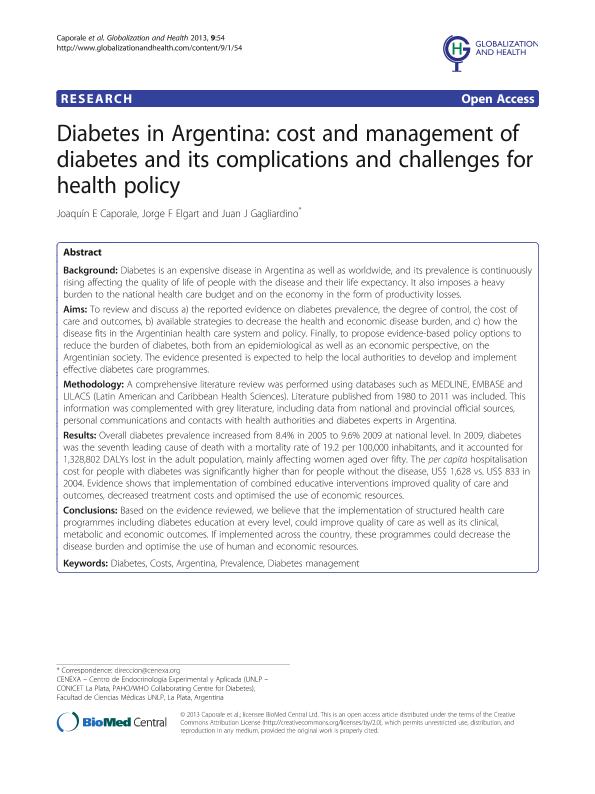Artículo
Diabetes in Argentina: cost and management of diabetes and its complications and challenges for health policy
Fecha de publicación:
10/2013
Editorial:
BioMed Central
Revista:
Globalization & Health
ISSN:
1744-8603
Idioma:
Inglés
Tipo de recurso:
Artículo publicado
Clasificación temática:
Resumen
Diabetes is an expensive disease in Argentina as well as worldwide, and its prevalence is continuously rising affecting the quality of life of people with the disease and their life expectancy. It also imposes a heavy burden to the national health care budget and on the economy in the form of productivity losses. Aims: To review and discuss a) the reported evidence on diabetes prevalence, the degree of control, the cost of care and outcomes, b) available strategies to decrease the health and economic disease burden, and c) how the disease fits in the Argentinian health care system and policy. Finally, to propose evidence-based policy options to reduce the burden of diabetes, both from an epidemiological as well as an economic perspective, on the Argentinian society. The evidence presented is expected to help the local authorities to develop and implement effective diabetes care programmes. Methodology: A comprehensive literature review was performed using databases such as MEDLINE, EMBASE and LILACS (Latin American and Caribbean Health Sciences). Literature published from 1980 to 2011 was included. This information was complemented with grey literature, including data from national and provincial official sources, personal communications and contacts with health authorities and diabetes experts in Argentina. Results: Overall diabetes prevalence increased from 8.4% in 2005 to 9.6% 2009 at national level. In 2009, diabetes was the seventh leading cause of death with a mortality rate of 19.2 per 100,000 inhabitants, and it accounted for 1,328,802 DALYs lost in the adult population, mainly affecting women aged over fifty. The per capita hospitalisation cost for people with diabetes was significantly higher than for people without the disease, US$ 1,628 vs. US$ 833 in 2004. Evidence shows that implementation of combined educative interventions improved quality of care and outcomes, decreased treatment costs and optimised the use of economic resources. Conclusions: Based on the evidence reviewed, we believe that the implementation of structured health care programmes including diabetes education at every level, could improve quality of care as well as its clinical, metabolic and economic outcomes. If implemented across the country, these programmes could decrease the disease burden and optimise the use of human and economic resources.
Palabras clave:
Diabetes
,
Costs
,
Prevalence
,
Diabetes Management
Archivos asociados
Licencia
Identificadores
Colecciones
Articulos(CCT - LA PLATA)
Articulos de CTRO.CIENTIFICO TECNOL.CONICET - LA PLATA
Articulos de CTRO.CIENTIFICO TECNOL.CONICET - LA PLATA
Articulos(CENEXA)
Articulos de CENTRO DE ENDOCRINOLOGIA EXP.Y APLICADA (I)
Articulos de CENTRO DE ENDOCRINOLOGIA EXP.Y APLICADA (I)
Citación
Caporale, Joaquin E.; Elgart, Jorge Elgart; Gagliardino, Juan Jose; Diabetes in Argentina: cost and management of diabetes and its complications and challenges for health policy; BioMed Central; Globalization & Health; 9; 10-2013; 2-10
Compartir
Altmétricas




